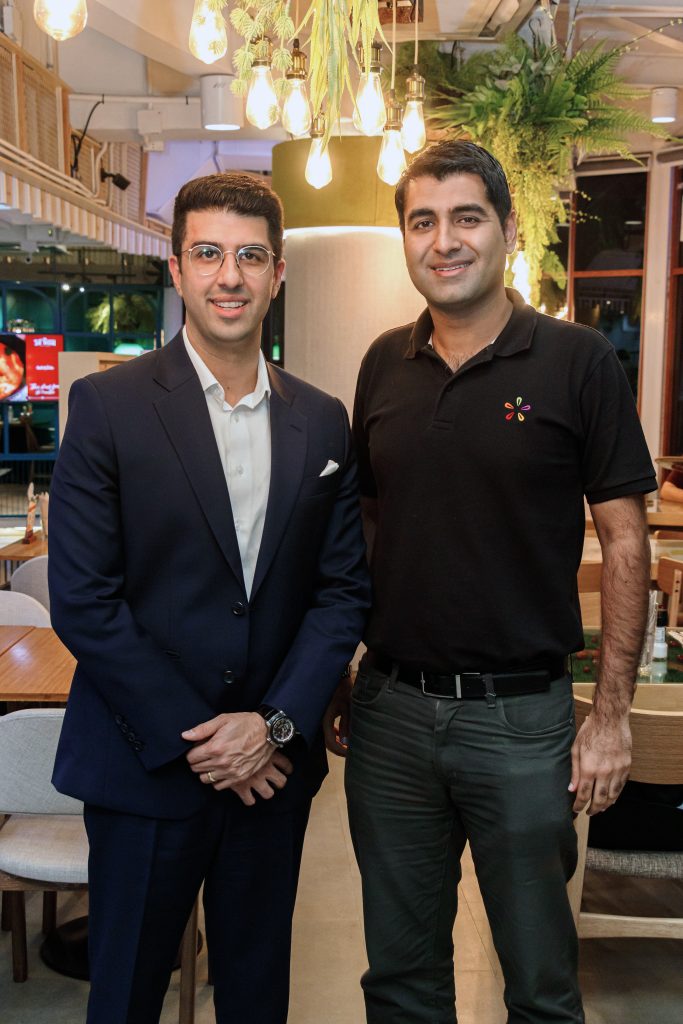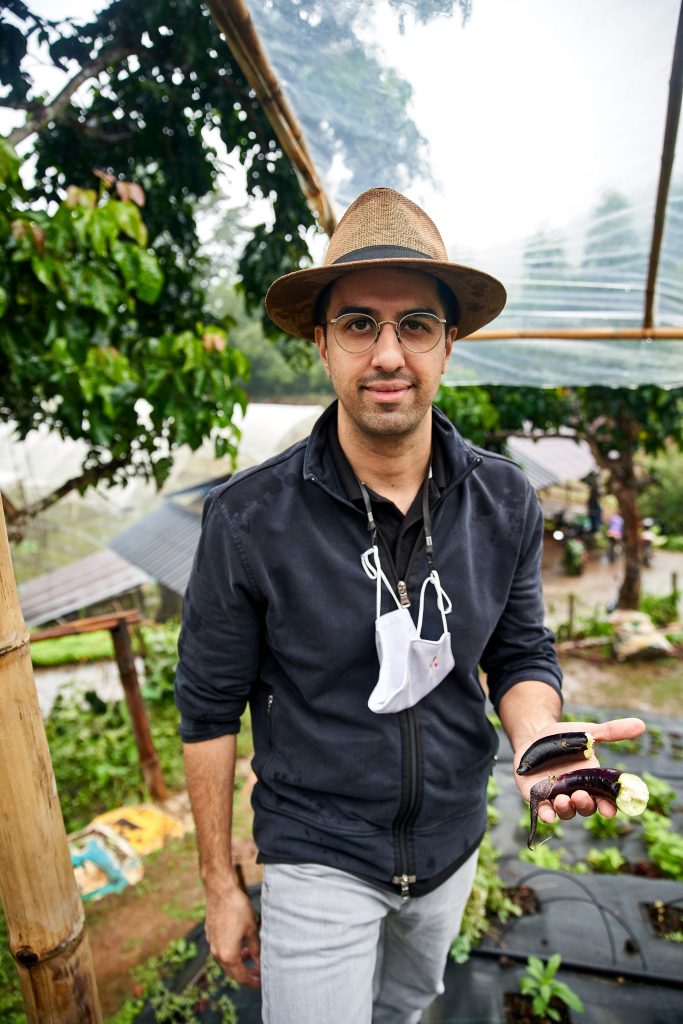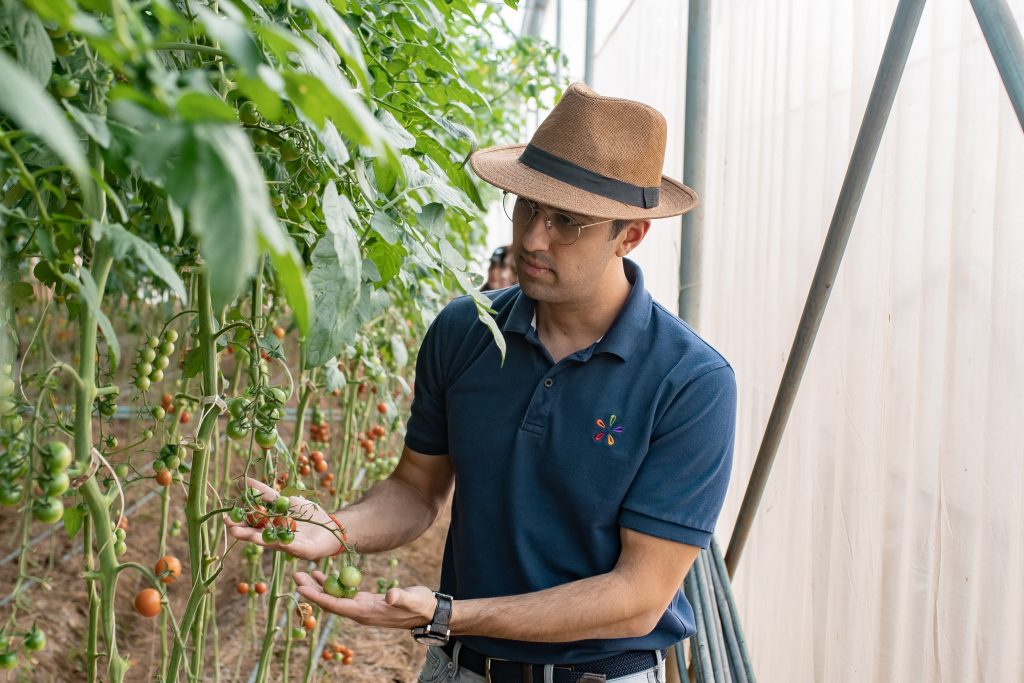What does the Managing Director of Indus and GetFresh have planned for the future?
By Ashima Sethi
As a journalist and someone who’s really grown to appreciate the diversity of Thailand’s food and beverage scene, I was excited for the opportunity to meet one of the community’s leading restaurateurs, Sid Sehgal, Managing Director of Indus and GetFresh.
I had the pleasure of sitting down with Sid at one of GetFresh’s newest branches inside Thonglor’s trendy J-Avenue lifestyle mall. As we begin talking, he doesn’t waste any time demonstrating his enthusiasm for the industry: “I graduated from the International School of Bangkok (ISB) before enrolling at New York University (NYU) to study Economics, Finance, and Marketing. While I was living in New York City, I worked in several bars and restaurants and that was my first taste of hospitality. I knew almost immediately it was what I wanted to do” he enthuses.
As both of Sid’s current ventures filled a gap in the market, Indus filling the need for an Indian dining experience that has cross-generational appeal, and GetFresh capitalising on the country’s newfound interest in healthy eating, I couldn’t help but ask how he managed to come up with his ideas. To which he shared, “In 2004, I was in college and I put on weight because I was eating junk. Shortly after, I noticed that my university housed a salad bar and I started visiting frequently in a bid to eat healthier. The concept was simple: choose your greens, toppings, and dressings. It was quick, cheap, fresh, and it helped me lose eight kilos! I knew that when I returned to Bangkok, I wanted to open something similar. That was the first seed that was planted,” he explains.
“When I was in New York, I also tried a lot of Indian restaurants. Some were fusion, some were traditional, but they were all unlike anything Bangkok had at the time. I thought, ‘wow, I had no idea that Indian food could be this good, and the service, ambience, and plating could be this well-done. In Bangkok, a lot of Indian restaurants back then were stuffy and formal and this resulted in Thais having a misled perception of Indian cuisine. I wanted to change that perception, so I had the goal of establishing a restaurant that was fun; one that hosted events, DJ nights, even a Sunday brunch. I wanted to curate a full dining experience.”
Not everyone can say they’ve been successful in transforming an idea into a physical business. As Sid’s portfolio of restaurants continue to grow as the months go on, I ask him to share his insight with Masala on why he believes his dining concepts have remained successful over time and in the wake of COVID-19, and what business advice he has for those who are also hoping to leave their mark on the industry.
You’ve introduced the visions you had at the beginning of your career in F&B, how did these ideas grow into the businesses they are today?
After university in 2005, I partnered with one of my closest friends Anchit Sachdev, who I told about my salad bar concept and my desire to see it through. We spent a lot of time travelling and doing research before we found Dressed, a franchise from Atlanta, USA, with several stores around the world. We decided to visit their headquarters in Hong Kong to enquire about buying the franchise rights to bring to Thailand.
Once we returned, we opened our first store inside Mercuryville in Langsuan and immediately signed on to open a second store in Siam Paragon. But disaster struck when the Red Shirt Protests began. Suddenly, we had two stores in the middle of the mob and we had a ton of issues to deal with. We worked instore to figure out what worked and what didn’t and it didn’t take us long to realise that the franchise system we were using just didn’t make sense. What worked for Hong Kong didn’t work here.
Our food costs were at 60 percent compared to an ideal 30 percent and we were bleeding heavily. We went back to HQ and told them, ‘look, we’ve done everything you’ve said to do and it’s just not sustainable.’ Thankfully, they gave us a freehand to make changes so Anchit and I implemented a ton, from menu to service style. Other franchisees who didn’t adapt slowly ended up out of business. All of a sudden, we weren’t a franchisee anymore. We were on our own.
What motivated you to transition Dressed into GetFresh?
Two years ago we got the call to meet with Stonelotus Ventures who wanted to invest in us because they loved our concept and believed we could go from five stores to 50, easily. You don’t say no to an offer like that. We started a company called Food Intellect that transitioned into The Fresh Food Company, which owns the intellectual property for GetFresh and its trademark in 10 countries that we hope to expand to across Asia. We’re at 10 stores now, double of last year, and we’re hoping to open another 10 next year.
With this growth, we needed a bigger team. We put in middle management, which we called the ExCom or ‘executive committee.’ There’s seven departments and each has a head, so it’s a much bigger company now with a proper corporate structure. We also felt that if we wanted to grow the company, it needed the right name. We did a focus group and GetFresh tested the best because it speaks for the feeling you get when you dine with us. We also changed how we operated so that everything became about the consumer. As part of marketing, we developed a persona called ‘Nong Fresh’ and the idea is that he/she is our creative bullseye. All decisions we make are based on what Nong Fresh would do.
What was different about growing Indus as a restaurant?
When I first started developing Indus, it was a restaurant called Whole Earth. It was pretty rundown by the time we took it over, so it definitely had its challenges. I ran Whole Earth for 14 months, slowly making improvements to the menu, interiors, and POS system. At the beginning, I definitely wasn’t qualified to open a restaurant, so running Whole Earth was a way for me to learn the business…the hard way, I might add.
In 2005, the biggest challenge was transforming Whole Earth into Indus, from the branding to a new menu. Cost control was especially tough. Too little and you will disappoint customers, too much and it’s not sustainable. You have to have just enough, and that requires maths, paper work, and diligence. It took over a year before Indus got to a point where I felt I was happy with it.
Before becoming a restaurateur, you worked in media and publishing. Did that experience help you with your career in F&B?
Absolutely. In my 15 years of working I’ve been in events, property development, I ran a travel company, and dabbled in solar energy. I also worked for my family’s magazine, Look East. We got invited to a lot of events and media trips, so I had the opportunity to dine with some of the brightest minds in the industry, including award-winning chefs. It also gave me the chance to interview professionals about the inner workings of the F&B scene. I really took as the opportunity to pick their brains and a lot of what I learned still influences me today.
In the years you’ve worked in the industry, how do you think Thailand’s restaurant scene has evolved?
I think it’s evolved immensely. In 2004, there were only a handful of places opening up at a given time. Now, I honestly can’t even keep up. I used to be really on top of the restaurant scene, but it’s moving really fast.
I think the fact that several Thailand-based restaurants are listed in the top 10 of Asia’s 50 Best says a lot about the scene here. Thailand is undeniably an impressive place for F&B because you’ve got such a big range in terms of pricing. You can eat at Chef’s Table at Lebua for around THB 15,000 per head but you can also eat very well for THB 50. In places like New York, you can’t eat very well for USD 1.50, but in Thailand, you can have very satisfying meals for all prices. Moreover, I would say here, people eat out the majority of the week. It’s also part of the social culture, we enjoy meeting over food. These are great factors for the restaurant business.
Furthermore, a lot of foreigners have come into the market in recent years. People like Gaggan Anand, Garima Arora, and David Thompson have come to Thailand and brought their wealth of experience here. That’s definitely helped put Thailand on the map in terms of gastronomy.
Do you think the Michelin Guide has also helped Thailand’s F&B scene grow?
For sure. In the same vein as what I just mentioned, there are many people who are ‘star collectors’ and travel the world to dine at Michelin-starred restaurants; many of them want to travel to Thailand specifically to try the food, and that’s not common for many countries.
In contrast, I know a lot of people who own Michelin-starred restaurants and some have fared well through the pandemic but many have had to drop their prices to appeal to the domestic market. So there’s good things and bad things about being recognised by Michelin.
Indus was the first Indian restaurant recognised in Thailand’s Michelin Guide, and the only one for the first two years. We’re not at star level, but I’m actually really happy where we are because I think the Michelin Plate indicates we’re doing something right but we’re also accessible to all diners.
So now that we’ve talked about how the industry has evolved, how has consumer behaviour changed?
With the younger generation, social media is important and this affects things like store design and plating. At Indus, we have a mix of generations visiting, but we recognise that we draw in the younger crowd because their friends are posting about the restaurant. We’ve always served our food with some flair. For example, we were one of the first to do biryani in a sealed pot that’s opened at the table. Recently, I visited Pahurat with a stylist to pick out fabrics we can use to craft fun corners and areas that people can use to take photos. We understand that pictures are drawing people in, so we’re happy to have our food look good, but the rule is it must be tasty too. We want to meet both requirements.
What are some of the current trends in the F&B industry that you think will continue?
I think traceability is gaining popularity. I’m glad because at GetFresh we’re big on tracing. So far, out of about 100 ingredients, we’ve traced about half of them. By trace, I mean we can give you the precise Google Map location of where it comes from. By 2021, it’s our mission to become 100 percent traceable.
The second trend is health benefits. After COVID-19, people are more motivated to take care of their bodies; they want to know the benefits of what they’re eating. I also believe using indigenous Thai ingredients is a trend that will continue flourishing. There are a lot of chefs who have started travelling around the country to find various herbs, spices, fruits, and vegetables, so that they can support local famers and showcase Thai ingredients at the same time.
I’ve also seen a lot of creativity in the market with things like dessert and beverages. In the past, bars definitely weren’t like this. Nowadays, we have local celebrity bartenders, we have bar takeovers, and fun collaborations. That stuff didn’t exist before so I think that will definitely continue to grow in the coming months.
COVID-19 has greatly affected the country’s F&B landscape, with many restaurants shuttering their doors after a difficult few months. How did you adapt?
For GetFresh, communication within the company changed. It used to be very top down, now it’s become more about evaluating a situation, looking at certain scenarios and what will happen if each scenario plays out, having everyone accept the consequences in advance as a team, and being prepared for all of them. We’ve flattened the org-charts, separating them into revenue team and expense team versus this department and that department as we did before. We definitely have a scenario mind set now versus a forecasting mind set.
How about the impact on running your restaurants?
I think during the COVID-19 period, it was the hardest I’ve ever worked in my life. We had about 130 staff for GetFresh and 40 for Indus, all of whom were relying on us. With that responsibility, we knew we didn’t have the option to sit back and relax. It was fight mode, ON. I got up every day at 6am and wouldn’t finish until 11pm. This was my routine seven days a week, for three months straight. Unfortunately, we did have to scale down on some of our team. We had temporary staff that we had to dismiss so we could focus on our core team. We also had to ask our team to accept a lower compensation for the initial months until things picked up.
On the revenue side, it was full steam ahead. We opened cloud kitchens across town for both Indus and GetFresh. These are stand-alone kitchens that can prepare our full menus for delivery. We also created a delivery department as part of the company, and our own direct delivery platform and website because we realised that 90 percent of our revenue was coming from third-party platforms. We still work with a few but we now have our own way of getting food to customers.
Our delivery business went through the roof during lockdown so there were definitely initial challenges setting up the infrastructure: the smart phones, the slip printing, the packaging, and getting drivers in and out in a timely manner. I’d say for both Indus and GetFresh, the numbers doubled what they were pre-COVID, which is great, but we actually prefer that customers dine-in because it’s less harmful on the environment. It involves less plastic, paper, and motorcycles.
We try to be as conscious as possible about our footprint and impact we have on the local communities. For example, during COVID-19, we introduced GetFresh’s ‘One-For One’ programme, where for every salad you order, we give one free to a healthcare worker. During that time, I think I went to over 20 hospitals, each with car loads of food for healthcare workers. We’re very thankful everyone ordered so many salads!
Our catering businesses also changed. There was no catering happening during the pandemic, so we decided to build the GetFresh Box and the Indus Box. This allows people to order, not only a set for themselves, but 50 or more of them if they’re hosting get-togethers and don’t want guests scooping from a buffet.
What do you predict for the future?
I’ve seen a lot of restaurants opening their doors in the last few months, which I believe is a good indicator that the impacts of COVID-19 are not here to stay. I don’t think the pandemic is going to stop the industry’s growth. It may give us a temporary slowdown, but Thailand has done phenomenally well to deal with the pandemic, that if there’s a second wave, I believe we will handle it even better.
From what I’ve seen, a lot of people in hospitality are going ahead with their plans, some of which have been adjusted to suit the current market. For example, we’ve seen a rise in smaller stores, kiosks, and use of delivery hubs. We’ve also adjusted our plans. For future GetFresh stores, we’re designing branches that will have a delivery window so that riders don’t have to come into the restaurant to pick up their orders. This is an efficient initiative born out of COVID-19.
Despite its devastation, COVID-19 has actually been incredible for our learning. It’s reinforced our belief that no matter what comes our way, we can survive it. During my 15 years working, my businesses have faced protests, floods, a pandemic, and now protests again. I don’t think a business owner will ever feel prepared for these kind of things, but from my experience, it’s all about staying positive, bullish, confident, and calculated.
In your opinion, is the Indian restaurant space getting too crowded?
No, not at all. All the restaurants are full! (laughs). I honestly think the Indian restaurant scene here is in its infancy and Indian food in Thailand still has a long way to go, but we’re really starting to see it evolve, and I’m excited to see what’s in store.
What are you planning for the immediate future?
As I previously mentioned, we’re hoping to establish 10 more GetFresh stores by next year. Currently, I don’t have plans to expand Indus because it’s a personal passion. I’m focusing on improving it as I feel like my vision for Indus is a never-ending pursuit of improvement rather than achieving perfection. I will say, that we’ve come across some incredible talent in India and we’re deciding what our next step is, whether it’s bringing them on board at Indus or doing something completely new by Indus. We’ll see what the future holds.
For more information about Sid’s ventures, visit www.indusbangkok.com and www.getfresh.co.th









